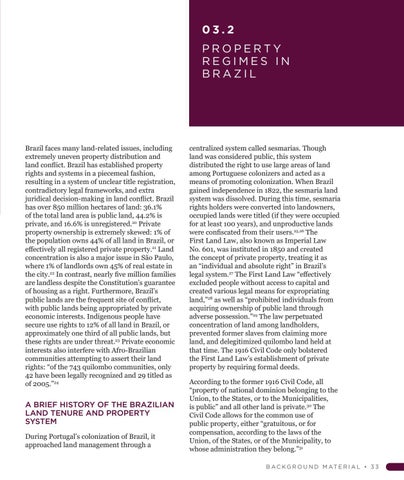03.2 PROPERTY REGIMES IN BRAZIL
Brazil faces many land-related issues, including extremely uneven property distribution and land conflict. Brazil has established property rights and systems in a piecemeal fashion, resulting in a system of unclear title registration, contradictory legal frameworks, and extra juridical decision-making in land conflict. Brazil has over 850 million hectares of land: 36.1% of the total land area is public land, 44.2% is private, and 16.6% is unregistered.20 Private property ownership is extremely skewed: 1% of the population owns 44% of all land in Brazil, or effectively all registered private property.21 Land concentration is also a major issue in São Paulo, where 1% of landlords own 45% of real estate in the city.22 In contrast, nearly five million families are landless despite the Constitution’s guarantee of housing as a right. Furthermore, Brazil’s public lands are the frequent site of conflict, with public lands being appropriated by private economic interests. Indigenous people have secure use rights to 12% of all land in Brazil, or approximately one third of all public lands, but these rights are under threat.23 Private economic interests also interfere with Afro-Brazilian communities attempting to assert their land rights: “of the 743 quilombo communities, only 42 have been legally recognized and 29 titled as of 2005.”24
A BRIEF HISTORY OF THE BRAZILIAN LAND TENURE AND PROPERTY SYSTEM During Portugal’s colonization of Brazil, it approached land management through a
centralized system called sesmarias. Though land was considered public, this system distributed the right to use large areas of land among Portuguese colonizers and acted as a means of promoting colonization. When Brazil gained independence in 1822, the sesmaria land system was dissolved. During this time, sesmaria rights holders were converted into landowners, occupied lands were titled (if they were occupied for at least 100 years), and unproductive lands were confiscated from their users.25,26 The First Land Law, also known as Imperial Law No. 601, was instituted in 1850 and created the concept of private property, treating it as an “individual and absolute right” in Brazil’s legal system.27 The First Land Law “effectively excluded people without access to capital and created various legal means for expropriating land,”28 as well as “prohibited individuals from acquiring ownership of public land through adverse possession.”29 The law perpetuated concentration of land among landholders, prevented former slaves from claiming more land, and delegitimized quilombo land held at that time. The 1916 Civil Code only bolstered the First Land Law’s establishment of private property by requiring formal deeds. According to the former 1916 Civil Code, all “property of national dominion belonging to the Union, to the States, or to the Municipalities, is public” and all other land is private.30 The Civil Code allows for the common use of public property, either “gratuitous, or for compensation, according to the laws of the Union, of the States, or of the Municipality, to whose administration they belong.”31 B A C K G R O U N D M AT E R I A L • 3 3













